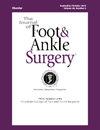Comparison outcomes of cheilectomy, hemi-implant arthroplasty and decompression osteotomy for the treatment of hallux rigidus: A retrospective study of 153 patients
IF 1.3
4区 医学
Q2 Medicine
引用次数: 0
Abstract
This retrospective case series investigated the treatment outcomes for hallux rigidus. A total of 153 patients (130 females, 49 males) were included. Of the 153 patients, 26 were bilateral and 179 procedures met the inclusion criteria. The patients had undergone 1 of the following procedures: cheilectomy (Group 1), hemi-implant arthroplasty (Group 2), decompression metatarsal osteotomy (DMO) (Group 3), and DMO with hemi-implant (Group 4). Mean patient age was 57 years (range 18-82), and the mean follow-up period was 26 months (range 12-72). All patients regardless of procedure had improvement in pain score with Group 4 demonstrating the greatest reduction in pain at 99 %. The majority of patients in the study had Stage II hallux limitus/rigidus (HL/HR) (67 patients), followed by 62 patients with Stage III and 49 patients with Stage IV. Preoperatively, the majority of patients lacked dorsiflexion at the first metatarsophalangeal joint. Group 1 gained 16° in dorsiflexion from preoperative to postoperative, Group 2 gained 20°, Group 3 gained 30° and Group 4 gained 24° by the 12 month followup. The results revealed that adhesions were the most common complication for all 4 surgical groups. These four surgical procedures for the treatment of Stage II, III and IV hallux rigidus are viable options and lead to satisfactory long-term outcomes that restore function, relieve pain and improve joint range of motion. Each procedure has demonstrated satisfactory long-term outcomes and high patient satisfaction.
153例拇僵直患者的回顾性研究:颧骨切除术、半假体关节置换术和减压截骨术的疗效比较。
本回顾性病例系列研究了拇僵直的治疗结果。共纳入153例患者,其中女性130例,男性49例。153例患者中,26例为双侧手术,179例符合纳入标准。患者接受了以下1种手术:颧骨切除术(1组),半种植体关节置换术(2组),跖骨减压截骨术(3组),半种植体关节截骨术(4组)。患者平均年龄为57岁(18-82岁),平均随访时间为26个月(12-72个月)。所有患者不论手术方式均有疼痛评分改善,其中第4组疼痛减轻幅度最大,达99%。该研究中大多数患者为II期拇趾受限/僵直(HL/HR)(67例),其次为62例III期和49例IV期。术前,大多数患者在第一跖趾关节缺乏背屈。随访12个月,1组术前至术后背屈增加16°,2组增加20°,3组增加30°,4组增加24°。结果显示,粘连是4个手术组最常见的并发症。这四种手术方法治疗II期、III期和IV期拇趾僵硬是可行的选择,并且在恢复功能、缓解疼痛和改善关节活动范围方面具有满意的长期效果。每一种手术都显示出令人满意的长期结果和较高的患者满意度。
本文章由计算机程序翻译,如有差异,请以英文原文为准。
求助全文
约1分钟内获得全文
求助全文
来源期刊

Journal of Foot & Ankle Surgery
ORTHOPEDICS-SURGERY
CiteScore
2.30
自引率
7.70%
发文量
234
审稿时长
29.8 weeks
期刊介绍:
The Journal of Foot & Ankle Surgery is the leading source for original, clinically-focused articles on the surgical and medical management of the foot and ankle. Each bi-monthly, peer-reviewed issue addresses relevant topics to the profession, such as: adult reconstruction of the forefoot; adult reconstruction of the hindfoot and ankle; diabetes; medicine/rheumatology; pediatrics; research; sports medicine; trauma; and tumors.
 求助内容:
求助内容: 应助结果提醒方式:
应助结果提醒方式:


